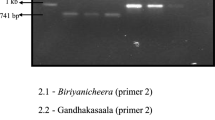Abstract
Information on the genetics of aroma in rice facilitates breeding and selection of new aromatic varieties with high yield and good quality. Objective of the present study was to make clear the number of genes controlling aroma, and the allelism of aroma genes and the location of aroma gene(s) on the chromosome in three Japanese native aromatic rice varieties (Kabashiko, Shiroikichi and Henroyori). Lack of leaf aroma in all F1 plants of non-aromatic/aromatic crosses indicated the recessive nature of aroma, and the segregation ratios (3:1) of non-aromatic to aromatic plants in its F2 populations from Nipponbare/aromatic varieties crosses revealed that each of the three aromatic varieties contains a single recessive gene for aroma. Through trisomic analysis, the segregation of non-aromatic and aromatic plants in all F2 populations from the crosses between trisomics lines NT8, with an extra chromosome 8, and aromatic varieties deviated significantly from disomic segregation of 3:1 ratios, and fitted to trisomic segregation, however, in other F2 populations derived from other 7 types of trisomic F1 plants, the segregation ratios of non-aromatic to aromatic were 3:1, indicating that the single recessive aroma gene was located on chromosome 8 in three aromatic varieties.
Similar content being viewed by others
References
Ahn, S.N., C.N. Bollich & S.D. Tanksley, 1992. RFLP tagging of a gene for aroma in rice. Theor Appl Genet 84: 825–828.
Berner, D.K. & B.J. Hoff, 1986. Inheritance of scent in American long grain rice. Crop Sci 26: 876–878.
Buttery, R.G., L.C. Ling, B.O. Juliano & J.G. Turnbaugh, 1983. Cooked rice aroma and 2–acetyl-1–pyrroline. J Agric Food Chem 31: 823–826.
Buttery, R.G., L.C. Ling & T.R. Mon, 1986. Quantitative analysis of 2–acetyl-1–pyrroline in rice. J Agric Food Chem 34: 112–114.
Dhulappanavar, C.V., 1976. Inheritance of scent in rice. Euphtica 25: 659–662.
Dhulappanavar, C.V. & S.W. Mensinkai, 1969. Inheritance of scent in rice. Karnataka Univ J 14: 125–129.
Dong Yanjun, H.D. Zhang & S.Y Shi, 1992. Genetic studies of aroma in the elite cytoplasmic male sterile (CMS) aromatic japonica line ShangbaiA IRRN (Vol.17) 2:5 IRRI Manila Philippines.
Ghose, R.L.M. & W.T. Butany, 1952. Studies on the inheritance of some characters in rice (Oryza sativa L.) Indian J Genet Plant Breed 12: 26–30.
Iwata, N., T. Omura & M. Nakagahara, 1970. Studies of on the trisomics in rice plants (Oryza sativa L.) I. Morphorogical classification of trisomics. Japan J Breed 20: 230–236.
Kadam, B.S. & V.K. Patankar, 1938. Inheritance of aroma in rice. Chron Bot 4: 32.
Lorieux, M., M. Petrov, N. Huang & E. Guiderdoni, 1996. Aroma in rice: genetic analysis of a quantitative trait. Theory Appl Genet 93: 1145–1151.
Matsuo, T., Y Futsuhara, F. Kikuchi & H. Yamaguchi, 1997. Science of the Rice Plant Volume Three (Genetics), pp. 186–188. Food and Agriculture Policy Research Center, Tokyo, Japan.
Nagaraju, M., D. Choudhary & M.J.B. Rao, 1975. A simple technique to identify scent in rice and inheritance pattern of scent. Curr Sci 44: 599.
Pinson S.R.M., 1994. Inheritance of aroma in six rice cultivars. Crop Sci 34: 1151–1157.
Reddy, P.R. & K. Sathyanarayaniah, 1980. Inheritance of aroma in rice. Indian J Genet Plant Breed 40: 327–329.
Siddiq E.A., A.R. Sadananda & F.U. Zaman, 1986. Use of primary trisomic of rice in genetic analysis. Rice Genetics Proc Int Rice Genetics Symp, Int Rice Res Inst, Manila, Philppines, pp. 185–197.
Sood, B.C. & E.A. Siddiq. 1978. A rapid technique for scent determination in rice. Indian J Genet Plant Breed 38: 268–271.
Tomar J.B. & S.C. Prassad, 1997. Genetic analysis of aroma in rice landraces. Oryza 34(3): 191–195.
Tripathi, R.S. & M.J.B.K. Rao, 1979. Inheritance and linkage of relationship of scent in rice. Euphytica 28: 319–323.
Tsuzuki, E., M. Kashino & N. Tasaki, 1991. Studies on the characteristics of scented rice — On the inheritance of aroma in rice (in Japanese). Rep Kyushu Br Crop Sci Soc Japan 58: 18–20.
Tsuzuki, E. & E. Shimokawa, 1990. Inheritance of aroma in rice. Euphytica 46: 157–159.
Yano M., E. Shimosaka, A. Sato & M. Nakagahra, 1991. Linkage analysis of a gene for scent in indica rice variety, Surjamkhi, using restriction fragment length polymorphism makers (in Japanese). Jpn J Breed 41(1): 338–339.
Author information
Authors and Affiliations
Rights and permissions
About this article
Cite this article
Dong, Y., Tsuzuki, E. & Terao, H. Trisomic genetic analysis of aroma in three Japanese native rice varieties (Oryza sativa L.). Euphytica 117, 191–196 (2001). https://doi.org/10.1023/A:1026502115436
Issue Date:
DOI: https://doi.org/10.1023/A:1026502115436




